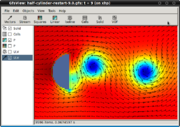THE INSTITUTE NEEDS YOUR HELP
IHM NASU was damaged by the attack of rashist drones
COMPUTER HYDROMECHANICS, 2024 (Program, Abstracts)
IX International Scientific & Practical Conference "Computer Hydromechanics"
RESEARCH DEPARTMENT OF APPLIED HYDRODYNAMICS
Created in 1981 on the basis of the Department of Filtration.
Head of the Department is a Corresponding Member of National Academy of Sciences of Ukraine Prof. Olexander Y. Oleinik.
Main research directions:
- studying of water filtration, heat and mass transfer and mass transfer in natural and artificial porous media;
- studying of transport of the sand, gravel and stony materials in wave hydrodynamic field in coastal waters and reservoirs at storm impacts.
Over the past few years, the following most important scientific results are obtained:
- mathematical models and methods for analytical and numerical solving of the problems on filtration of ground water in the complex natural and man-made conditions with taking into account of the suffusion and colmatage at flooding and drainage areas and individual objects;
- mathematical models and methods for calculation of migration of various contaminants in the areas of influence of the tailing dumps, storage capacitors of liquid effluents, as well as solid industrial and domestic waste, reclaimed agricultural territories;
- mathematical models and methods for calculation of engineering constructions in the purification of waste water from a variety of inorganic and organic compounds;
- mathematical models and numerical methods for solving of the systems of nonlinear equations for water filtration and heat and mass transfer in porous media with the properties varying due to physical, chemical and biochemical phase transitions;
- methods of physical and mathematical modeling are developed, laws of the hillslope forming materials movement are studied in the conditions of the coastal waters and reservoirs, areas of influence of new types of bank protection structures, storm impacts.
Scientific developments of the department are implemented and continue to be implemented in the environmental forecasting and scientific substantiation for systems of engineering protection of territories and individual objects from the damaging effects of ground- and surface water, as well as in designing of new equipment and technological modes for water treatment plants.





